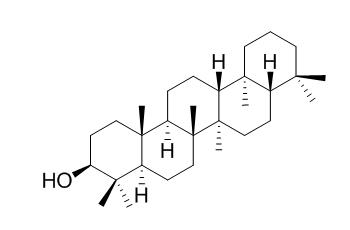Tetrahymanol
Tetrahymanol, the most likely precursor of gammacerane, occurs ubiquitously in marine sediments.
Inquire / Order:
manager@chemfaces.com
Technical Inquiries:
service@chemfaces.com
Tel:
+86-27-84237783
Fax:
+86-27-84254680
Address:
1 Building, No. 83, CheCheng Rd., Wuhan Economic and Technological Development Zone, Wuhan, Hubei 430056, PRC
Providing storage is as stated on the product vial and the vial is kept tightly sealed, the product can be stored for up to
24 months(2-8C).
Wherever possible, you should prepare and use solutions on the same day. However, if you need to make up stock solutions in advance, we recommend that you store the solution as aliquots in tightly sealed vials at -20C. Generally, these will be useable for up to two weeks. Before use, and prior to opening the vial we recommend that you allow your product to equilibrate to room temperature for at least 1 hour.
Need more advice on solubility, usage and handling? Please email to: service@chemfaces.com
The packaging of the product may have turned upside down during transportation, resulting in the natural compounds adhering to the neck or cap of the vial. take the vial out of its packaging and gently shake to let the compounds fall to the bottom of the vial. for liquid products, centrifuge at 200-500 RPM to gather the liquid at the bottom of the vial. try to avoid loss or contamination during handling.
Separations2023, 10(7), 411.
University of Manitoba2023, 37433.
Molecular & Cellular Toxicology 2024, 00444-8.
Int J Mol Sci.2024, 25(23):12733.
Heliyon.2023, 9(12):e22932.
Nutrients.2021, 13(1):254.
Molecules.2017, 22(11)
Molecules.2019, 24(19):E3417
Journal of Apiculture2019, 34(2):131-136
Sci Rep.2017, 7(1):3249
Related and Featured Products
Geochimica Et Cosmochimica Acta, 1989, 53(11):3073-3079.
Tetrahymanol, the most likely precursor of gammacerane, occurs ubiquitously in marine sediments[Reference:
WebLink]
METHODS AND RESULTS:
Tetrahymanol has been identified in several sediment samples from different depositional environments by gas chromatography-mass spectrometry and by coinjections with an authentic standard. Together with literature data this shows that Tetrahymanol is likely to be widespread, which is in accordance with the ubiquitous occurrence of its presumed diagenetic product, gammacerane, in more mature sediments and crude oils. The diagenetic conversion of Tetrahymanol to gammacerane most likely proceeds via dehydration and subsequent hydrogenation. The intermediate in this conversion, gammacer-2-ene, has been synthesized, and its presence in one sample confirmed by coinjections.
CONCLUSIONS:
The identification of Tetrahymanol in marine sediments indicates either that protozoa of the genus Tetrahymena are widely distributed or that Tetrahymanol is also a natural product of organisms other than Tetrahymena.
Microbiology, 1990, 136(12):2551-2553.
Tetrahymanol from the phototrophic bacterium Rhodopseudomonas palustris: First report of a gammacerane triterpene from a prokaryote[Reference:
WebLink]
Tetrahymanol, a rare triterpene from the gammacerane series, previously detected only in a few scattered eukaryotic taxa, has been isolated for the first time from the phototrophic bacterium Rhodopseudomonas palustris. This extends the significance of geochemical markers from this series, which are abundant in marine sediments and palaeohypersaline environments.



